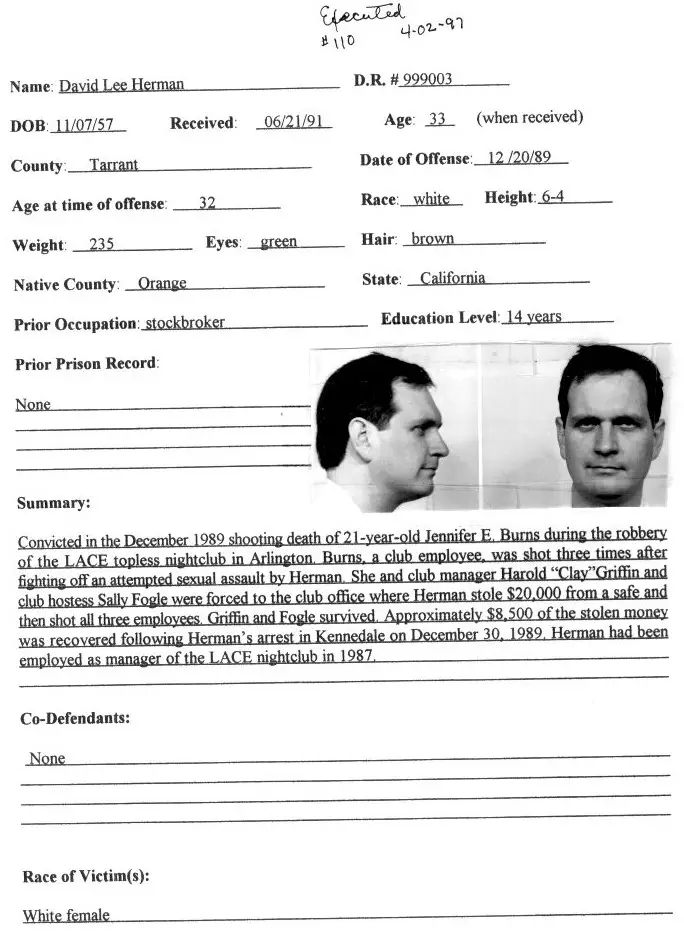David
Lee
Herman,
sentenced to death for the murder of
Jennifer Burns, seeks to appeal the
district court's denial of his petition
for writ of habeas corpus. We dismiss
his appeal.
While
robbing the Lace Club in Arlington,
Texas, David
Lee
Herman shot
three people. One of the three, Ms.
Burns, died. Before
Herman's trial for capital murder,
his attorney asked the state trial judge
to submit a fourth issue to the jury in
the punishment stage of the trial. The
issue asked, "Do you find any aspect of
the defendant's character that would
justify life in prison rather than death?"
In the
alternative, Herman's
attorney asked that the trial court
inform the parties what instructions the
court would give the jury regarding the
application of mitigating evidence in
the punishment phase. The defense argued
this information would be important to
it during voir dire of prospective
jurors. The court denied both defense
requests, and stated it would properly
instruct the jury as to mitigating
evidence if mitigating evidence were
later submitted.
At
voir dire, both parties were allowed
wide latitude to examine prospective
jurors' attitudes towards the death
penalty, their ability to understand and
answer special issues, and their ability
to consider mitigating evidence. Defense
counsel repeatedly asked potential
jurors what standard of proof they would
use to determine if mitigating evidence
presented for Herman
was sufficient to support a sentence of
life imprisonment rather than death. The
prosecution successfully objected to
these questions on the ground they were
irrelevant to qualification as a juror,
since the standard of evidence used to
evaluate mitigating evidence is a legal
standard and not a factual matter
appropriate for voir dire.
Herman now
argues his voir dire was impermissibly
restricted so that he was deprived of
his right to intelligently use his
peremptory challenges. He contends this
deprivation impaired his rights to due
process and the effective assistance of
counsel under the Fifth, Sixth, Eighth
and Fourteenth Amendments.
Herman
exhausted his direct appeals, was denied
certiorari by the United States Supreme
Court, and unsuccessfully sought relief
through Texas habeas proceedings.
Herman then
sought federal habeas relief. The
district court denied the habeas
petition and denied
Herman's application for
certificate of probable cause.
Herman now
petitions this court for that
certificate.
II. Application
for Certificate of Probable Cause to
Appeal
Herman did not
move for Certificate of Probable Cause
with this court, instead filing a notice
of appeal of the district court's denial
of his petition for writ of habeas
corpus. In the past, a habeas petitioner
sentenced to death who files a notice of
appeal has had his notice treated as an
application for a certificate of
probable cause. Jones v. Whitley, 938
F.2d 536, 538 (5th Cir.1991). Since
Herman
requested a certificate of probable
cause from the district court, and his
appellate brief requested a certificate
of probable cause to appeal, we treat
his notice of appeal to this court as a
request for a certificate.
III. Application
of the Antiterrorist and Effective Death
Penalty Act of 1996
On
April 24, 1996, the President signed the
Antiterrorist and Effective Death
Penalty Act of 1996 ("the Act"), which
amends the procedures to be followed by
habeas petitioners who wish to appeal
denial of their application for habeas
relief.1
Previously, petitioners were required to
obtain a certificate of probable cause
("CPC") to appeal. Under the amended law,
petitioners must obtain a certificate of
appealability ("COA") instead.
The
Act requires an appellate court grant a
COA "only if the applicant has made a
substantial showing of the denial of a
constitutional right." 28 U.S.C. §
2253(c)(2) (emphasis added). A CPC could
only be issued if a substantial showing
of the denial of a federal right was
made. Barefoot v. Estelle, 463 U.S. 880,
103 S.Ct. 3383, 77 L.Ed.2d 1090 (1983).
Whether the requirements for a COA
should apply to pending applications for
a CPC has already been the subject of
some discussion in other circuits.
The
Second and Tenth Circuits both recently
held the Act applicable to pending
applications for certificates of
probable cause. Reyes v. Keane, 90 F.3d
676, 679-81 (2nd Cir.1996); Lennox v.
Evans, 87 F.3d 431 (10th Cir.1996). The
Reyes court explained that "the
substantive standard for a COA is the
same as the standard for the prior CPC."
90 F.3d at 680.
The
Ninth Circuit has stated otherwise,
noting in discussion of another section
of the Act that the COA standard is more
demanding than that for a CPC. Williams
v. Calderon, 83 F.3d 281, 286 (9th
Cir.1996). However, that court has twice
specifically declined to address whether
the Act applies to pending applications.
Id. at 286; Lowell v. Prunty, 91 F.3d
1358 (9th Cir.1996).
The
Lowell court noted the earlier language
in Williams that commented stricter
criterion exist for issuing a COA than a
CPC. It then, however, refused to
officially hold a COA imposed a higher
standard than a CPC. The court only went
so far as to accept the view that if a
petitioner could not make a showing
sufficient for issuance of a CPC, he
could not receive a COA: "In cases such
as this in which appellant does not meet
the CPC standard under pre-Act law, a
fortiori appellant could not meet a more
demanding standard." Id. at 1359.
While
we make no determination whether the
standards for issuance of a COA are
higher than the standards for a CPC, nor
whether COA applies to pending appeals
of denial of habeas, we hold Appellant
made no showing he was denied either a
federal or constitutional right. He
therefore failed to meet the standards
for either a CPC or COA.
In
Harris v. Johnson, this court set out
the standards for issuance of a CPC:
To obtain a CPC, [the
petitioner] must make a substantial
showing of the denial of a federal right.
"This standard does not require
petitioner to show that he would prevail
on the merits, but does require him to
show the issues presented are debatable
among jurists of reason." Further, in a
capital case we properly may consider
the nature of the penalty in deciding
whether to grant a CPC but, as we have
observed, that fact alone does not
suffice to justify the issuance of a CPC.
Harris
v. Johnson, 81 F.3d 535, 538 (5th
Cir.1996) (citations omitted).
In
appeals alleging violations of the
requirements of voir dire in state court
cases, federal courts are limited to
enforcing the commands of the United
States Constitution. Mu'Min v. Virginia,
500 U.S. 415, 422, 111 S.Ct. 1899, 1903,
114 L.Ed.2d 493 (1991). Trial court
judges have traditionally been afforded
much latitude in choosing how to conduct
voir dire, and their decisions on voir
dire are usually respected by appellate
courts as within the trial court's
discretion. Id. at 422-23, 111 S.Ct. at
1903-04.
Herman argues
he is entitled to a CPC because the
trial court's refusal to inform him what
instruction would be given to jurors in
the penalty trial on evaluating
mitigating evidence deprived him of his
right to intelligently exercise his
peremptory challenges.
However, peremptory challenges are not
constitutional rights, Georgia v.
McCollum, 505 U.S. 42, 57, 112 S.Ct.
2348, 2358, 120 L.Ed.2d 33 (1992), and
Herman does not
claim that non-constitutional federal
rights were violated. Beyond the
limitation that challenges may not be
used for the purposes of excluding
jurors solely on the basis of race or
gender, J.E.B. v. Alabama ex rel. T.B.,
511 U.S. 127, 114 S.Ct. 1419, 128 L.Ed.2d
89 (1994), there are few other rights
connected to peremptory challenges. The
Supreme Court has stated:
[W]e reject the
notion that the loss of a peremptory
challenge constitutes a violation of the
constitutional right to an impartial
jury. We have long recognized that
peremptory challenges are not of
constitutional dimensions. They are a
means to obtain the end of an impartial
jury. So long as the jury that sits is
impartial, the fact that the defendant
had to use a peremptory challenge to
achieve that result does not mean the
Sixth Amendment was violated.
Ross
v. Oklahoma, 487 U.S. 81, 88, 108 S.Ct.
2273, 2278, 101 L.Ed.2d 80 (1988) (citations
omitted).
The
trial court judge was soundly within his
discretion when he refused to allow
detailed questioning of veniremen on the
legal standard they would use to
evaluate mitigating evidence.
Herman never
alleged the jury seated in his trial was
unfair or unable to properly evaluate
mitigating evidence. The judge afforded
both parties considerable latitude in
investigating possible juror bias in
voir dire, and was under no obligation
to give Herman
the very wide license he sought. See,
e.g., Mu'Min, 500 U.S. 415, 111 S.Ct.
1899. Herman
has made no showing that the trial
court's refusal to allow
Herman to
question individual veniremen on this
topic was a denial of any federal or
constitutional right.
Thus
Herman would
not have been entitled to CPC and is not
entitled to COA.
For
that reason, the motion for a
certificate of probable cause is DENIED.


